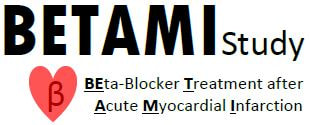It remains unknown whether β-blockers reduce mortality and recurrent myocardial infarction (MI) in contemporary revascularized patients without reduced LVEF following acute (A)MI. Three pivotal studies did show an incremental effect on survival, but that was more than thirty years ago. Since then, reperfusion, revascularization and effective secondary prophylaxis measures have been introduced.
The study is a prospective, randomized, open label, blinded endpoint evaluation (PROBE) multicenter superiority trial to test whether BB therapy, a treatment established in the early eighties, is still effective following MI. It will include a total of 10'000 patients with a first or recurrent AMI who are treated with primary PCI or thrombolysis. Patients will be randomized 1-8 days following PCI or thrombolysis and allocated to either prescription of a β-blocker or to no such prescription after written, informed consent. The working hypothesis is that 'β-blocker treatment’ is superior to 'No β-blocker treatment' in such patients in terms of all-cause mortality and recurrent MIs over an average follow-up period of 3 years.
Primary and secondary objectives of the project
- The primary objective is to test whether oral β-blocker therapy reduces the risk of all-cause death or non-fatal myocardial AMI compared to no such therapy, in patients with MI treated with percutaneous coronary intervention (PCI) or thrombolysis and no clinical signs of heart failure and/or left ventricular ejection fraction (LVEF) of more or equal to 40%.
- The key secondary objectives are (1) To study whether oral β-blocker therapy reduces the risk of ventricular arrhythmias, all cause death, new MI or hospitalization for heart failure compared to no such therapy (2) To perform a cost-utility analysis in relation to quality of life and a health economic evaluation including drug use, health care utilization, employment, income, and benefit take-up (3) To compare sociodemographic, clinical, and psychosocial characteristics (PROMS and clinical data) between the two study arms and in the total sample.
Inclusion criteria (brief):
Primary and secondary objectives of the project
- The primary objective is to test whether oral β-blocker therapy reduces the risk of all-cause death or non-fatal myocardial AMI compared to no such therapy, in patients with MI treated with percutaneous coronary intervention (PCI) or thrombolysis and no clinical signs of heart failure and/or left ventricular ejection fraction (LVEF) of more or equal to 40%.
- The key secondary objectives are (1) To study whether oral β-blocker therapy reduces the risk of ventricular arrhythmias, all cause death, new MI or hospitalization for heart failure compared to no such therapy (2) To perform a cost-utility analysis in relation to quality of life and a health economic evaluation including drug use, health care utilization, employment, income, and benefit take-up (3) To compare sociodemographic, clinical, and psychosocial characteristics (PROMS and clinical data) between the two study arms and in the total sample.
Inclusion criteria (brief):
- 18 years or older
- AMI according to universal definition
- Treated with PCI or thrombolysis
- Clinical heart failure and/or reduced left ventricle ejection fraction (< 40%)
- Conditions requiring β-blocker treatment
- β-blocker contraindications
- Women of chilbearing potential
